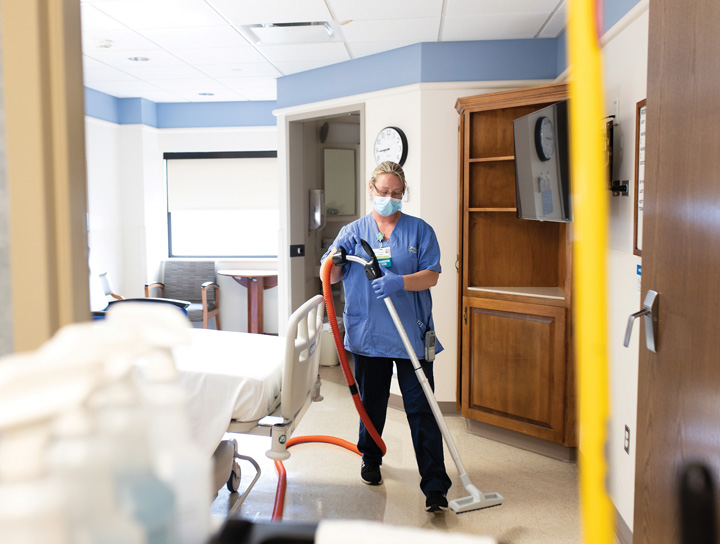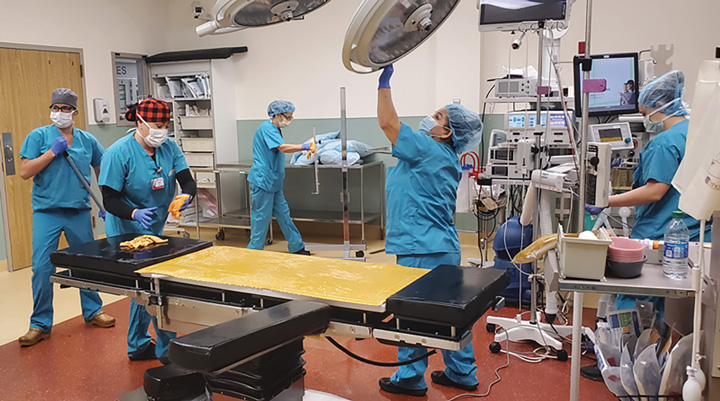- Home
- Article
Keep Your OR Air Clean
By: Danielle Bouchat-Friedman | Senior Editor
Published: 7/7/2023
Eliminate pesky airborne microbial burden that has the potential to contaminate surgical wounds and cause post-op infections.
Your OR may seem spotless and sterile, but tiny airborne particles could still be lingering in the air, potentially causing post-op surgical site infections (SSIs).
According to a recent study published in Journal of Global Infectious Diseases, SSIs account for 26.9% of all hospital-acquired infections (HAIs). The study notes that the estimated incidence of HAIs exceeds that of many other reportable diseases in the United States.
What’s more, yearly estimated costs attributable to HAIs in the U.S. are between $35 and $88 billion. While the study acknowledges that it has been historically accepted that pathogens responsible for HAIs often originate largely from surfaces, research suggests that airborne microbial burden also constitutes a substantial percentage of the overall pathogens responsible for HAIs.
This is why hospitals and ASCs are investing in air purification systems, from portable units to ceiling-mounted ultraviolet-C (UVC) fixtures. Here’s some of the technology on the market and how facilities are using it to keep their OR air clean and their patients safe from SSIs.
HEPA filters and air exchanges
There are national air filtration standards for hospitals that need to be on your radar. While the air delivered to clinical areas typically consists of a mixture of external and recirculated air, the study explains that the exact composition of the delivered air varies depending on the particular clinical area. For example, the American National Standards Institute/American Society of Heating, Refrigerating, and Air-Conditioning Engineers/American Society for Healthcare Engineering Standard 170–2017, Ventilation of Health-care Facilities, requires a minimum of 20 air changes per hour (ACH) for an operating room with a minimum of four outdoor ACH, the study authors write.
Hospitals rely on high-efficiency particulate air (HEPA) filters to process the air entering critical spaces, which are designed to remove particulates and reduce the levels of biological contamination within a space. As the study points out, this type of air filter can remove at least 99.97% of dust, pollen, mold, bacteria and airborne particles with a size of 0.3 microns. “Because HEPA devices are designed to capture particulates, any retained particulates are likely to remain inside the filter matrix and the viable particulates (bacteria, viruses and mold/fungi) may continue to grow and multiply. Subsequently, the force from sustained high air velocities across the filter can cause previously entrapped variables to separate from the HEPA matrix, thereby allowing them to become entrained in the airflow and enter the space,” the study authors note.
Ceiling-mounted UVC fixtures
Matthew Patterson, a regional director for a management company that provides hospital housekeeping, is a big fan of surface and ceiling-mounted UVC fixtures, which are designed to be used in unoccupied spaces for improved air and surface sterilization. When short-wavelength UVC light is deployed, it kills or inactivates microorganisms by destroying nucleic acids and disrupting their DNA.
“If I had my perfect world, all ORs would be equipped with UV lights that turn on as soon as the room closes,” he says.
The main disadvantage when deploying these technologies is time. “Your staff must stay out of the room when they are in use,” says Mr. Patterson, “and you must take the intensity of the bulb into consideration.” He thinks a good rule of thumb for UV lights is five minutes at eight feet with a perfect line of sight, but to be sure, his team relies on dose verification cards. “You place a card in a room that starts off yellow. Once the card turns light green, that means that you’ve effectively killed Methicillin-resistant Staphylococcus aureus and vancomycin-resistant enterococci. When the card turns dark green, that’s when you know the UV has killed up to and including Clostridioides difficile, an envelope spore. On a scale of one to 10, C. diff is a 10 on the hardest to kill because it can live on a surface uninterrupted for up to six months,” warns Mr. Patterson.
Anytime a facility installs a new UV light, Mr. Patterson likes to place dose verification cards in a few different places. “If I’m in a patient room, for example, I put them on high-touch surface areas, like the bed and side rail. I’m going to put one on the bed, and one on the side rail. I go into the room about every two minutes to see if the card has changed color until it gets to that dark green,” he says.
If I had my perfect world, all ORs would be equipped with UV lights that turn on as soon as the room closes.
Matthew Patterson
But Mr. Patterson reiterates that UV light isn’t meant to replace your staff’s current manual cleaning efforts. “This technology is something that you can use in addition to your current cleaning methods; it’s a complement, not a substitution,” notes Mr. Patterson.
Benjamin D. Galvan, MLS(ASCP), CIC, CPH, director of infection prevention at HCA Florida South Tampa Hospital, agrees. “The CDC mentions the use of ultraviolet germicidal irradiation technology as a supplemental method of air disinfection; however, it should not be used as a substitute for HEPA filtration and utility can be limited and dependent on the technology chosen,” he says. “Based on conferences I’ve attended, air purification technologies appear to be expanding — I think the evidence and research just needs to catch up before it becomes more universally used.”
Mobile UVC units

Instead of permanently installing UVC lights in every OR, St. Elizabeth Healthcare in Edgewood, Ky., utilizes mobile UVC technology. These mobile devices employ HEPA filtration and UVC disinfection and can easily be placed in an OR to take in and treat contaminated air. Matthew L. Greis, SASHE, CHFM, system director of facilities for the multi-hospital system, prefers this method not just because it is less expensive, but because the units are equipped with motion sensors. “Any time something moves in the room, the motion sensors are alerted, and the units shut off,” says Mr. Greis. “Granted, we usually treat the rooms using these units when we do terminal cleans to make sure that we’re creating the most sterile environment we possibly can, but the motion sensors offer that extra piece of mind and help keep our staff safe.”
But Mr. Greis points out that all of the hospital system’s filtration happens at the air handling unit, which is a machine that is designed to handle and condition the air that is processed in the HVAC system. Mr. Greis says thus far, the unit has prevented any airborne illness issues of any kind. He knows of other facilities without air handling units that had to add laminar flow diffusers with HEPA filters to reduce the concentration of unwanted air particles in a room.
Risk vs. reward

So how do you determine which air purification system is right for your facility? At a minimum, Mr. Greis recommends at least one, if not two, mobile UV units to treat the OR during terminal cleaning. But don’t run and buy every piece of technology without first considering the procedures your facility is performing and your infection rates. “As with any supplemental form of environmental disinfection, it depends on risk versus reward,” says Mr. Galvan. “ASCs that are performing high-risk procedures may leverage supplemental technology to mitigate the risk of infection from all sources even if they don’t have high infection rates.” Another thing to consider is how the technology will impact your patient population. “The technology may provide patients with a greater level of comfort and security knowing that they are having surgery where this type of technology is used,” says Mr. Galvan. OSM
.svg?sfvrsn=be606e78_3)
.svg?sfvrsn=56b2f850_5)